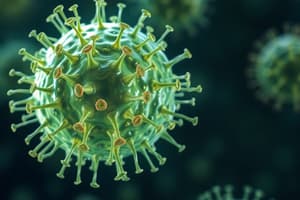Podcast
Questions and Answers
Which mechanism of antibiotic resistance involves the use of proteins that actively transport the antibiotic out of the bacterial cell?
Which mechanism of antibiotic resistance involves the use of proteins that actively transport the antibiotic out of the bacterial cell?
- Target Modification
- Efflux Pumps (correct)
- Enzymatic Inactivation
- Failure to Activate
How does enzymatic inactivation lead to antibiotic resistance?
How does enzymatic inactivation lead to antibiotic resistance?
- By directly pumping the antibiotic out of the cell
- By modifying or degrading the antibiotic molecule (correct)
- By preventing the antibiotic from entering the cell
- By altering the antibiotic target site
A bacterium develops resistance to vancomycin by modifying its peptidoglycan precursors. What specific alteration is most likely responsible for this resistance?
A bacterium develops resistance to vancomycin by modifying its peptidoglycan precursors. What specific alteration is most likely responsible for this resistance?
- Decreased production of peptidoglycan
- Incorporation of D-ala-D-lac (correct)
- Increased production of transpeptidase
- Incorporation of D-ala-D-ala
Which of the following resistance mechanisms is associated with mutations in the bacterial ribosome?
Which of the following resistance mechanisms is associated with mutations in the bacterial ribosome?
Metronidazole requires activation to damage DNA. Which mechanism would lead to resistance against metronidazole?
Metronidazole requires activation to damage DNA. Which mechanism would lead to resistance against metronidazole?
How does the presence of an outer membrane contribute to antibiotic resistance in Gram-negative bacteria?
How does the presence of an outer membrane contribute to antibiotic resistance in Gram-negative bacteria?
Which of the following enzymes is NOT involved in enzymatic inactivation of antibiotics?
Which of the following enzymes is NOT involved in enzymatic inactivation of antibiotics?
How do selective porins contribute to bacterial resistance?
How do selective porins contribute to bacterial resistance?
Which of the following modifications in Lipid A leads to antibiotic resistance?
Which of the following modifications in Lipid A leads to antibiotic resistance?
What is the primary function of bacterial flavodoxin in the context of antibiotic resistance?
What is the primary function of bacterial flavodoxin in the context of antibiotic resistance?
A bacterium becomes resistant to an antibiotic through a mutation that alters the antibiotic's target enzyme. Which of the following mechanisms describes this type of resistance?
A bacterium becomes resistant to an antibiotic through a mutation that alters the antibiotic's target enzyme. Which of the following mechanisms describes this type of resistance?
Which resistance mechanism allows bacteria to tolerate tetracycline even in the presence of the antibiotic?
Which resistance mechanism allows bacteria to tolerate tetracycline even in the presence of the antibiotic?
Why is it important for bacteria to regulate the expression of antibiotic resistance genes, rather than constantly expressing them?
Why is it important for bacteria to regulate the expression of antibiotic resistance genes, rather than constantly expressing them?
How does clavulanic acid overcome antibiotic resistance?
How does clavulanic acid overcome antibiotic resistance?
What is the role of the KatG enzyme in antibiotic resistance?
What is the role of the KatG enzyme in antibiotic resistance?
Which statement accurately describes antibiotic tolerance?
Which statement accurately describes antibiotic tolerance?
What role do efflux pumps play in antibiotic resistance in gram-negative bacteria?
What role do efflux pumps play in antibiotic resistance in gram-negative bacteria?
Which of the following is the mechanism of resistance for macrolide antibiotics?
Which of the following is the mechanism of resistance for macrolide antibiotics?
Which mechanism explains vancomycin resistance via modification of peptidoglycan?
Which mechanism explains vancomycin resistance via modification of peptidoglycan?
In Staphylococcus aureus, how is beta-lactamase production regulated?
In Staphylococcus aureus, how is beta-lactamase production regulated?
How do bacteria become resistant to Isoniazid?
How do bacteria become resistant to Isoniazid?
What role to toxin-antitoxin systems play in bacterial resistance?
What role to toxin-antitoxin systems play in bacterial resistance?
In E. coli, what transcriptional event occurs as a result of beta-lactam antibiotics in the presence of nagZ mutations?
In E. coli, what transcriptional event occurs as a result of beta-lactam antibiotics in the presence of nagZ mutations?
Which is NOT a mechanism of antibiotic resistance?
Which is NOT a mechanism of antibiotic resistance?
Flashcards
Restriction of Access
Restriction of Access
Outer membrane barrier, selective porins, and efflux pumps limit drug entry.
Enzymatic Inactivation
Enzymatic Inactivation
Enzymes like beta-lactamase, aminoglycoside modifying enzymes, or CAT modify or degrade drugs.
Target Modification or Protection
Target Modification or Protection
Alteration of PBPs, DNA gyrase, rRNA, or Lipid A prevents drug binding.
Failure to Activate Antibiotic
Failure to Activate Antibiotic
Signup and view all the flashcards
Outer Membrane Porins
Outer Membrane Porins
Signup and view all the flashcards
Antibiotic Efflux Pumps
Antibiotic Efflux Pumps
Signup and view all the flashcards
Serine β-Lactamases
Serine β-Lactamases
Signup and view all the flashcards
Clavulanic Acid
Clavulanic Acid
Signup and view all the flashcards
Zinc β-Lactamases
Zinc β-Lactamases
Signup and view all the flashcards
Aminoglycoside Inactivators
Aminoglycoside Inactivators
Signup and view all the flashcards
Penicillin-Binding Protein (PBP) Resistance
Penicillin-Binding Protein (PBP) Resistance
Signup and view all the flashcards
Vancomycin Resistance Mechanism
Vancomycin Resistance Mechanism
Signup and view all the flashcards
Macrolide Resistance
Macrolide Resistance
Signup and view all the flashcards
Colistin Resistance
Colistin Resistance
Signup and view all the flashcards
Ribosome Protection
Ribosome Protection
Signup and view all the flashcards
Metronidazole Resistance
Metronidazole Resistance
Signup and view all the flashcards
Isoniazid Resistance
Isoniazid Resistance
Signup and view all the flashcards
Antibiotic Resistance
Antibiotic Resistance
Signup and view all the flashcards
Antibiotic Tolerance
Antibiotic Tolerance
Signup and view all the flashcards
Persisters
Persisters
Signup and view all the flashcards
Study Notes
Antibiotic Resistance Mechanisms of Action
- Antibiotic resistance mechanisms include limiting antibiotic access, enzymatic inactivation, target modification/protection, and failure to activate the antibiotic.
Restriction of Access to Target
- Bacteria restrict access to the target using outer membrane barriers, selective porins, and efflux pumps.
- Outer membrane porins are selective gatekeepers, allowing small molecules to diffuse through the periplasm.
- Antibiotics like vancomycin and daptomycin are too large to pass through.
- Efflux pumps have been discovered for nearly every class of antibiotic.
- Gram-negative pumps span both membranes and use proton motive force to pump antibiotics from the periplasm.
- Gram-positive efflux pumps are simple anti-porters or ABC transporters.
Enzymatic Inactivation
- Serine β-lactamases are common in gram-negative bacteria and cleave the beta-lactam ring of antibiotics.
- The mechanism is similar to the β-lactam's action on the transpeptidase enzyme.
- β-lactams can be administered with a β-lactamase inhibitor, and clavulanic acid inactivates β-lactamase.
- Zinc β-lactamases (metallo β-lactamases) cleave antibiotics at a different site.
- Clavulanic acid and other inhibitors cannot interact with the zinc form.
- Zinc β-lactamases can cleave a wider range of β-lactams than serine β-lactamases.
- Kanamycin or gentamycin can be inactivated by the addition of modifying groups.
- Modifications disrupt the interaction of antibiotics with their cellular target (30S ribosome via 16S rRNA).
Target Modification or Protection
- Penicillin-binding protein (PBP) resistance is common in gram-positive bacteria (MRSA/VRE).
- Modification prevents the binding of the β-lactam ring and involves modification of existing amino acids.
- Clavulanic acid cannot block this type of resistance.
- Vancomycin resistance occurs when antibiotic normally prevents peptide interbridge formation by binding strongly to D-ala-D-ala residues in the stem peptide, preventing transpeptidase from linking the cross-bridge.
- Vancomycin binds D-Ala-D-Lac about 1000-fold less efficiently than D-Ala-D-Ala, which explains resistance.
- In macrolide resistance, RNA methylases add methyl groups to residue A2058 in the 23S RNA target site of the ribosome.
- The antibiotic can no longer bind to the large subunit and block polypeptide exit.
- In colistin resistance, the mechanism includes modification of LPS.
- Ribosome protection by TetO, TetM, and TetQ mediates tetracycline resistance.
- A new modified version of tetracycline called glycylglycines (tigecycline) overcomes these resistance mechanisms.
Failure to Activate the Antibiotic
- Metronidazole resistance results when the drug, a prodrug, is not activated by flavodoxin.
- Less flavodoxin leads to failure to activate.
- Absence of activation damages DNA by causing nicks.
- Isoniazid resistance occurs when the drug is not activated by KatG (catalase).
- Isoniazid blocks mycolic acid synthesis so no activation results in no inhibition of the cell wall.
- Resistance stems from altered expression or function of KatG.
Regulation of Resistance
- Expression of antibiotic resistance often comes as a fitness tradeoff.
- Efflux pumps derive their energy for transport through the proton motive force, competing with ATPases for ATP production.
- Beta-lactamase production in Staphylococcus aureus and AmpC regulation in E. coli are also regulated processes.
- Translational attenuation is used for Erythromycin resistance
Resistance, Tolerance, and Persisters
- Resistance is when bacteria can still grow in the presence of the antibiotic.
- Tolerance is when bacteria stop growing when the antibiotic is present but are not killed.
- When antibiotic levels fall, the tolerant bacteria can resume growth.
- Persisters are a small sub-population of cells (1%) that temporarily stop dividing playing an important role in biofilm physiology and antibiotic tolerance.
- Toxin-antitoxin (TA) systems induce growth arrest or dormancy.
Studying That Suits You
Use AI to generate personalized quizzes and flashcards to suit your learning preferences.



